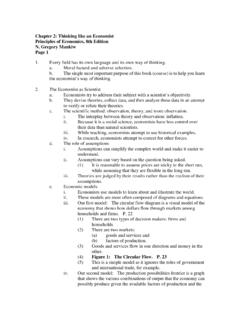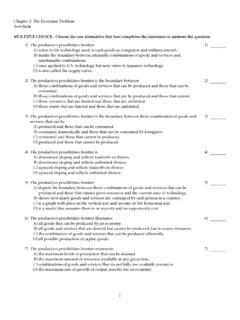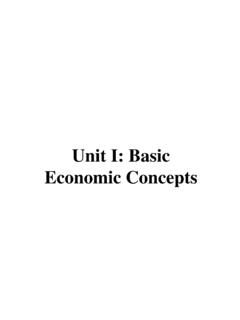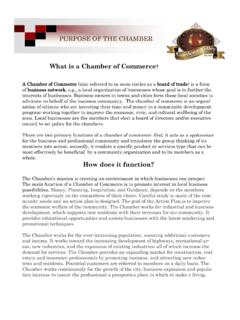Transcription of The Race between Man and Machine: Implications of ...
1 American Economic Review 2018, 108(6): 1488 1542 Race between Man and machine : Implications of Technology for Growth, Factor Shares, and Employment By Daron Acemoglu and Pascual Restrepo*We examine the concerns that new technologies will render labor redundant in a framework in which tasks previously performed by labor can be automated and new versions of existing tasks, in which labor has a comparative advantage, can be created. In a static version where capital is fixed and technology is exogenous, automation reduces employment and the labor share, and may even reduce wages, while the creation of new tasks has the opposite effects. Our full model endogenizes capital accumulation and the direction of research toward automation and the creation of new tasks. If the long-run rental rate of capital relative to the wage is sufficiently low, the long-run equilibrium involves automation of all tasks.
2 Otherwise, there exists a stable balanced growth path in which the two types of innovations go hand-in-hand. Stability is a consequence of the fact that automation reduces the cost of producing using labor, and thus discourages further automation and encourages the creation of new tasks. In an extension with heterogeneous skills, we show that inequality increases during transitions driven both by faster automation and the introduction of new tasks, and characterize the conditions under which inequality stabilizes in the long run. (JEL D63, E22, E23, E24, J24, O33, O41)The accelerated automation of tasks performed by labor raises concerns that new technologies will make labor redundant ( , Brynjolfsson and McAfee 2014; Akst 2013; Autor 2015). The recent declines in the labor share in national income and the employment to population ratio in the United States ( , Karabarbounis and Neiman 2014; Oberfield and Raval 2014) are often interpreted as evidence for the claims that as digital technologies, robotics, and artificial intelligence penetrate the economy, workers will find it increasingly difficult to compete against machines, and their compensation will experience a relative or even absolute decline.
3 * Acemoglu: Department of Economics, MIT, 77 Massachusetts Avenue, Cambridge, MA 02142 (email: Restrepo: Department of Economics, Boston University, 270 Bay State Road, Boston, MA 02215 (email: This paper was accepted to the AER under the guidance of Mark Aguiar, Coeditor. We thank Philippe Aghion, David Autor, Erik Brynjolfsson, Chad Jones, John Van Reenen, three anon-ymous referees, and participants at various conferences and seminars for useful comments and suggestions. We are grateful to Giovanna Marcolongo and Mikel Petri for research assistance. Jeffrey Lin generously shared all of his data with us. We also gratefully acknowledge financial support from the Bradley Foundation, the Sloan Foundation, and the Toulouse Network on Information Technology. Restrepo thanks the Cowles Foundation and the Yale Economics Department for their hospitality.))
4 Go to to visit the article page for additional materials and author disclosure statement(s).1489 ACEMOGLU AND RESTREPO: THE RACE between MAN AND MACHINEVOL. 108 NO. 6 Yet, we lack a comprehensive framework incorporating such effects, as well as potential countervailing need for such a framework stems not only from the importance of understanding how and when automation will transform the labor market, but also from the fact that similar claims have been made, but have not always come true, about previous waves of new technologies. Keynes famously foresaw the steady increase in per capita income during the twentieth century from the introduction of new technologies, but incorrectly predicted that this would create widespread technological unemployment as machines replaced human labor (Keynes 1930). In 1965, economic historian Robert Heilbroner confidently stated that as machines continue to invade society, duplicating greater and greater numbers of social tasks, it is human labor itself at least, as we now think of labor that is gradually rendered redundant (quoted in Akst 2014, p.)
5 2). Wassily Leontief was equally pes-simistic about the Implications of new machines. By drawing an analogy with the technologies of the early twentieth century that made horses redundant, in an inter-view1 he speculated that Labor will become less and less More and more workers will be replaced by machines. I do not see that new industries can employ everybody who wants a job. This paper is a first step in developing a conceptual framework to study how machines replace human labor and why this might (or might not) lead to lower employment and stagnant wages. Our main conceptual innovation is to propose a framework in which tasks previously performed by labor are automated, while at the same time other new technologies complement labor : specifically, in our model this takes the form of the introduction of new tasks in which labor has a comparative advantage.
6 Herein lies our answer to Leontief s analogy: the difference between human labor and horses is that humans have a comparative advantage in new and more complex tasks. Horses did not. If this comparative advantage is significant and the creation of new tasks continues, employment and the labor share can remain stable in the long run even in the face of rapid importance of new tasks is well illustrated by the technological and organizational changes during the Second Industrial Revolution, which not only involved the replacement of the stagecoach by the railroad, sailboats by steamboats, and of manual dock workers by cranes, but also the creation of new labor-intensive tasks. These tasks generated jobs for engineers, machinists, repairmen, conductors, back-office workers, and managers involved with the introduction and operation of new technologies ( , Landes 1969; Chandler 1977; and Mokyr 1990).
7 Today, as industrial robots, digital technologies, computer-controlled machines, and artificial intelligence replace labor, we are again witnessing the emergence of new tasks ranging from engineering and programming functions to those performed by audio-visual specialists, executive assistants, data administrators and analysts, meeting planners, and social workers. Indeed, during the last 35 years, new tasks and new job titles have accounted for a large fraction of US employment growth. To document this fact, we use data from Lin (2011) to measure the share of new job titles, jobs in which workers perform tasks that are different from tasks in previously 1 Charlotte Curtis, Machines vs. Workers, The New York Times, February 8, AMERICAN ECONOMIC REVIEWJUNE 2018existing jobs , within each occupational category. In 2000, about 70 percent of com-puter software developers (an occupational category employing one million people at the time) held new job titles.
8 Similarly, in 1990 radiology technician and in 1980 management analyst were new job titles. Figure 1 shows that occupations with 10 percentage points more new job titles (which is approximately the sample average in 1980) experienced percent faster employment growth between 1980 and 2015. This estimate implies that about 60 percent of the 50 million or so jobs added during this 35-year period are associated with the additional employment growth in occupations with new job titles (relative to occupations with no new job titles).2We start with a static model in which capital is fixed and technology is exogenous. There are two types of technological changes: automation allows firms to substitute capital for tasks previously performed by labor, while the creation of new tasks enables the replacement of old tasks by new variants in which labor has a higher productivity.
9 Our static model provides a rich but tractable frame-work that clarifies how automation and the creation of new tasks shape the pro-duction possibilities of the economy and determine factor prices, factor shares in national income, and employment. Automation always reduces the labor share and employment, and may even reduce Conversely, the creation of new tasks 2 The relationship shown in Figure 1 controls for the demographic composition of employment in the occupation in 1980. In online Appendix B, we show that the same relationship holds between the share of new job titles in 1990 (in 2000) and employment growth from 1990 to 2015 (from 2000 to 2015), and that these patterns are present without any controls and when we control for average education in the occupation and the structural changes in the US economy as well.
10 The data for 1980, 1990 and 2000 are from the US Census. The data for 2015 are from the American Community Survey. Additional information on the data and our sample is provided in online Appendix B. 3 The effects of automation in our model contrast with the Implications of factor-augmenting technologies. As we discuss in greater detail later and in particular in footnote 19, the effects of factor-augmenting technologies Share of new job titles in 1980 Employment growth 1980 20155%10%0% 5%Figure 1. Employment Growth by Occupation between 1980 and 2015 (Annualized) and the Share of New Job Titles in 19801491 ACEMOGLU AND RESTREPO: THE RACE between MAN AND MACHINEVOL. 108 NO. 6increases wages, employment, and the labor share. These comparative statics follow because factor prices are determined by the range of tasks performed by capital and labor, and shifts in technology alter the range of tasks performed by each factor (see also Acemoglu and Autor 2011).






